Only More Licensed Stores Will Solve New York’s Gray Market Pot Problem

Legal cannabis on sale in New York (photo: John McCarten NYC Council Media Unit)
Law-enforcement sources, anti-gentrification community boards, and other detractors have been up in arms for more than a year about the many smoke shops selling unlicensed cannabis in New York, which have grown to dominate the retail market for the substance.
According to their narrative, these stores are turning New York City into an urban hellscape. But their criticism is more than a bad-faith dog whistle about a legal substance. It’s actively allowing the gray market to flourish.
Here's the simple reason why: When detractors make noise about gray market cannabis, they cement in the minds of cannabis consumers the false equivalency that cannabis purchased in the state’s vibrant gray market is of the same quality as the good, legal stuff available in licensed retail locations. They're validating the gray market every time they criticize it.
That is a key contributor to the fact that, right now, New Yorkers have an alarming amount of misplaced trust in gray market cannabis. We know this because we asked them.
An estimated 1.6 million New Yorkers report having used cannabis within the past 30 days, according to a 2020 study administered by the CDC. We surveyed 384 of them, asking questions about the prevalence of the gray market for cannabis. We expected to validate the conventional wisdom that it persists merely because of convenience, but our results were more nuanced and informative than that.
Among the New York cannabis users we surveyed who “sometimes” or “always” shop in the gray market, 71% say they trust the products have been tested for contaminants, and 70% trust they’re accurately labeled. But there are no testing requirements for cannabis sold in the gray market, and there is significant counterfeiting. When the products are accurately labeled, it's because they were smuggled in from out of state.
We also found that, despite this trust, most New Yorkers don’t have positive experiences with gray-market cannabis.
Sixty-five percent of respondents who shopped in the gray market said the product didn’t get them high enough, while 30% said it got them too high, and 31% said it smelled or tasted weird. A smaller but not-insignificant 12% of shoppers said cannabis products purchased from gray market retailers made them sick. This suggests the longer the gray market lingers, the more it will become a genuine public health threat.
Our respondents also said that price is just as important a factor as convenience when purchasing cannabis.
Forty-two percent said it’s important to know if a shop is licensed.
We found that medical cannabis certificate holders, who have better access to licensed, regulated products, are far less likely to shop at gray market retailers; meanwhile, the state has been doing a disappointing job of allowing more legal recreational dispensaries to open their doors to the public.
This polling data directly from cannabis users makes an iron-clad case for more licensed dispensaries, which in turn suggests that more progressive, not more restrictive, policy is necessary for New York’s cannabis market to function in a safe, lawful way.
There are still just 13 licensed recreational dispensaries open in New York State, with five clustered in one three-mile radius in Manhattan, and 40 medical dispensaries. To grow these numbers, the licensing process should be faster. Cannabis stores should have multiple financing and banking options. Policy should better incent landlords to lease vacant commercial space in well-off neighborhoods, perhaps through a larger tax on unoccupied space or an auction system to fill tenants.
The cannabis community dislikes unsafe retailers. A licensed, regulated retailer in every community will solve this problem. There's certainly no lack of demand.
We get it. Regulating this newly legal space is hard, and every state that does it operates from an inherent position of weakness because cannabis still exists in statutory no-man’s-land, banned at the federal level but commonly legal or decriminalized at the state or municipal level.
But, more than two years after New York passed recreational cannabis into law, there is still a clear lack of access to convenient, licensed, and regulated cannabis in practically all areas of the state. All New Yorkers deserve better.
***
Alex Milligan is co-founder and CMO of NuggMD.com, the nation’s largest telemedicine platform for cannabis.
***
Have an op-ed idea or submission for Gotham Gazette? Email This email address is being protected from spambots. You need JavaScript enabled to view it.
Our Chance to Increase AAPI Representation in New York City Government
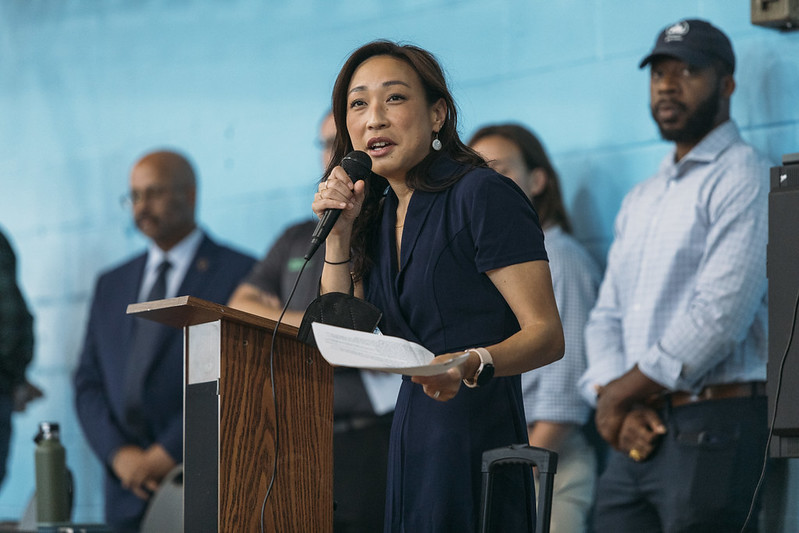
City Council Member Linda Lee, the author (photo: Emil Cohen/NYC Council Media Unit)
Despite being the fastest-growing immigrant group within New York City, the Asian American Pacific Islander (AAPI) community still severely lacks representation in government. In New York City, only 5% of my fellow City Council Members identify as AAPI, while none of our citywide electeds do. The population of Asian residents increased by 7% since 2010, but we haven’t seen a proportional increase in representation in the City Council, especially when it comes to AAPI women. While we did achieve greater representation in 2021, that cannot be the ceiling, but rather the foundation on which we build.
Not only are we a growing demographic group, but across all five boroughs we are reshaping New York’s socioeconomic landscape, generating nearly $121 billion in economic activity, and contributing to our city’s rich cultural fabric.
Our communities need adequate representation, now more than ever. Anti-Asian hate continues to threaten our communities. In 2021, hate crimes against Asian American adults increased by 361%, according to NYPD data. Meanwhile, we face persistently high poverty levels and research from the Asian American Federation finds that roughly 30% of the AAPI community is rent-burdened, driving severe overcrowding in AAPI households.
If we want to address these issues, it’s incumbent upon us to platform and support candidates that deeply understand our communities. On practically every level of government, AAPI women are still vastly underrepresented. We hold elected office at lower rates than Asian American men and make up only 1% of state legislatures, according to the Rutgers Center for American Women and Politics.
As an AAPI woman running for re-election, I am fearlessly committed to tackling the socioeconomic issues my community is facing head on, but I can’t do it alone. We need to make a real, coordinated effort to get more AAPI women elected.
The New Majority NYC (formerly 21 in ‘21) has invested resources and built networks for AAPI candidates like myself, actively working to dismantle the existing power structures that overwhelmingly still benefit white male candidates. The organization has a history of upending the status quo, and this year, through investing in my candidacy and seven more AAPI women candidates across five districts, they are refusing to squander the opportunity to ensure that New York City Council Districts that are majority-AAPI are represented by AAPI women.
And they’re using ranked-choice endorsements to make that happen. Ranked-choice voting has virtually eliminated the vote-splitting that disproportionately harms candidates of color. Through utilizing ranked-choice endorsements, The New Majority NYC supports a continued commitment to electing candidates that reflect the diversity of their communities.
The New Majority NYC’s endorsement and support made a major difference in my first race, in 2021, when the organization also helped elect the Council’s first-ever women majority. Through their support petitioning to get on the ballot and connecting me with mentors, voters, donors, and networks, they helped dismantle the barriers that so many AAPI women running for office traditionally face.
As the AAPI community continues to grow, in our city and across the country, it’s clear that our communities deserve a voice across all levels of government. New York has the opportunity to be a leader in AAPI representation in government and be an example for our nation in truly diverse representation.
***
City Council Member Linda Lee represents parts of Eastern Queens. On Twitter @LindaLeeforNYC.
***
Have an op-ed idea or submission for Gotham Gazette? Email This email address is being protected from spambots. You need JavaScript enabled to view it.
There are Just Two Big Issues in New York’s Elections; We Need Voters and Candidates to Prioritize Them
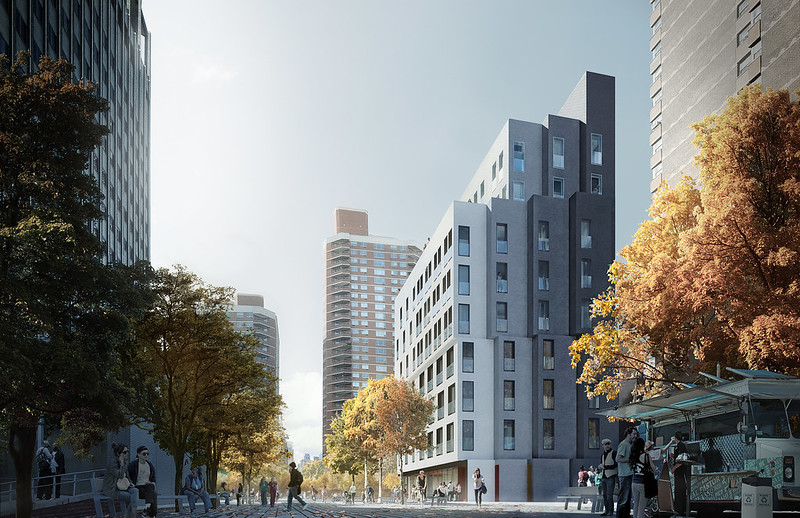
Housing in focus (photo: Mayor's Office)
On June 27, most people in this city will do nothing out of the ordinary. More than three-quarters of New Yorkers will go about their day like any other Tuesday.
But the remaining 25% or so — if we’re lucky — will get to decide most of the 51 members of the New York City Council. The majority of those voters (including those who vote early or by mail) will also cast a ballot for a district attorney, judge, or other local office.
In yet another New York City election with such low turnout, lots of things can make the difference between winning and losing – which candidate had a friendly post shared on the local parents’ Facebook group or who proposed a policy that ticked off a particularly motivated interest group, for example. Unfortunately, these factors can push candidates to focus on small-ball, too often at the cost of the larger picture and electorate. The result is that our politics plays footsie around the edges instead of tackling the big problems.
But the truth is, there are only really two things that matter to this whole city. If we get them right, everything else gets easier. If we ignore them, we are left struggling, trying to put band-aids on our problems. This is the simple recipe: First, more people should be able to live where they want to live. Second, more people should be able to get around without a private car.
It’s news to nobody that living in New York City costs a lot of money. Life in this city is rapidly becoming unattainable to all but the wealthiest among us, and this affordability crisis is largely driven by a chronic deficit of housing. In the latest Census, we learned that New York City grew by more than 629,000 people between 2010 and 2020. Yet, during the same period, we only built 206,000 housing units. The numbers don’t add up.
We should be building housing like the life of our city depends on it, because it does. People want to live here, and we should be a city that wants them too. We are all better off when we welcome new neighbors with open arms instead of a cold shoulder – whether they are recent college graduates, retirees, immigrants, or anybody else that wants to be part of the New York story. Despite their outsized voices, this has never been a town of NIMBYs, our brand is acceptance and tolerance and opportunity. And the only way to keep this promise of our city alive for this generation and future ones is to build homes for more New Yorkers.
Policies that encourage housing abundance will make our communities safer and more vibrant. Without the heavy burden of astronomical rents, more New Yorkers will be empowered to take creative and entrepreneurial risks, and more New Yorkers will sleep better without the dangling threat of losing their homes after one bad break.
And when more people can afford to live in New York City and the communities here they want to live in, we need to make it safer, cleaner, and less expensive to get around them. That ultimately means that we need to build our city around people, not automobiles.
This manifests in what are called “complete” streets, which are reimagined with pocket parks, bike lanes, pedestrian safety improvements, accessible loading zones, and perhaps most viscerally impactful of all, containerized waste collection. The rats will hate this. The driver of a jacked-up pickup truck doing 50 in a school zone will hate this. But every time we try this, we see that New Yorkers love it.
Next, we need to think big about other forms of transit. We built 467 subway stops in the first hundred-ish years of the system – but only five stops in this millennium. Some people need a car; there are lots of valid reasons to own and operate one. This is not about banning cars, it’s about minimizing car dependency and all the negative things that come with it — crashes, pollution, noise, and isolation — and maximizing mobility and opportunity, health and happiness.
We can take big steps in that direction with new and repurposed rail service, especially in “transit deserts” outside Manhattan. Our transit system made New York a world capital in the last century. We must not allow ourselves to believe that new transportation projects are only a thing of the past.
Housing and transportation. Those are the universal issues. Depending on our lives, other things can of course certainly matter a whole lot, particularly policing and criminal justice, education, sanitation, social services, the environment and more. And within each of those areas, there is also a world of nuance. This does not diminish their very real importance.
But the big picture is simple. Make this a city that people can live in — a city where people can afford decent housing and where people can get around easily — and the rest will follow. If you’re one of the few that chooses to cast a vote on June 27, make it one for candidates that will answer these issues.
***
Ben Guttmann is a marketing executive, adjunct professor at Baruch College, and author of Simply Put: Why Clear Messages Win – and How to Design Them, to be released by Berrett-Koehler Publishers in October. On Twitter @guttmann.
***
Have an op-ed idea or submission for Gotham Gazette? Email This email address is being protected from spambots. You need JavaScript enabled to view it.
NYC Department of Education Fails to Plan for Mandatory Class Size Reduction

DOE Chancellor Banks with Mayor Adams (photo: Michael Appleton/Mayor's Office)
Class size has been an enduring concern of parents and teachers alike and a deep flaw of New York City schools for nearly a century. As far back as 1930, during the administration of Mayor Jimmy Walker, the New York Times concluded that excessive class sizes were the “chief problem” of the public schools:
“There is hardly any disagreement that smaller classes are desirable and that individualized instruction is better than mass teaching, but the task of substantially reducing the average size of class [is] the most drastic and serious confronting the board [of education] and the city.”
Some progress has been made over the last century, but not enough. In 2003, in the Campaign for Fiscal Equity (CFE) case, New York’s highest court concluded that excessive class sizes had deprived New York City students of their right under the state constitution to a sound basic education. And though both Mayors Michael Bloomberg and Bill de Blasio pledged to reduce class size during their campaigns, neither one fulfilled that promise, and as of this fall, more than 230,000 students were still crammed into classes of 30 or more.
As written during the 2021 mayoral campaign by Gothamist’s Elizabeth Kim, “For some New York City education policy experts, the mission of reducing class sizes can be likened to a holy grail.“
But in June 2022, the State Legislature finally had enough. Especially as the long-delayed funding from the CFE lawsuit was due to be finally awarded to city schools — $1.3 billion phased in over three years — Senators John Liu, the chair of his chamber’s New York City education committee, and Robert Jackson, the original plaintiff in the CFE lawsuit, spearheaded the passage of a new law that required what city officials had long failed to accomplish: to lower class sizes.
The bill, signed into law by Governor Hochul in September, requires that all class sizes in public schools be gradually capped over the next five years to no more than 20 students per class in grades K-3, 23 students per class in grades 4-8, and 25 students per class in high school, with an additional 20% of classes meeting those limits every year.
Because of overall enrollment declines, there is little doubt that the New York City Department of Education will meet the first year benchmark of 20% at or below these levels. This past fall, 38% of classes citywide were at or below the mandated caps, compared to 42% last year. Class sizes increased at most schools this year because of budget cuts to schools, causing the loss of teachers and important programs. In fact, New York City public schools have lost 4,000 K-12 teachers over the last five years.
It is far less likely that the Department of Education (DOE) will meet the 40% mandate in 2025 if current trends continue, and nearly impossible that these caps will be met in years three to five without significant changes to school funding, enrollment policies, and the capital plan for school construction — none of which the DOE intends to do. In fact, DOE policies are moving in the wrong direction.
The DOE recently posted a draft class size "plan" in preparation for borough and Community Education Council hearings that will occur this month (June).
But here are some of the important steps that DOE has failed to take:
None of the additional $500 million in CFE funding (called Contract for Excellence funding in the law) will be targeted specifically towards hiring additional teachers to lower class sizes. According to a City Council analysis, another 817 full-time teaching positions are due to be lost if the mayor’s proposed budget is adopted, although the DOE is projecting a minimal enrollment decline of less than 1% and an actual increase in high school enrollment next year.
Even though the DOE has assured the public that initial school budgets for the upcoming 2023-2024 school year will remain the same as initial budgets for this year, big cuts in funding that can be used to keep teachers on staff are being replaced with increased funding for specified purposes, such as professional development. Moreover, less funding is likely to come over the course of the year in contrast to past years. In fact, the initial budgets schools are receiving for next year are about $800 million less than they were as of March of this year. As a result, we have already heard of schools that will be forced to excess teachers -- again.
Despite the fact that more than 300,000 students were crammed into overcrowded schools this year, the School Construction Authority is instead proposing to cut the number of new seats by 38%, compared to the plan adopted in June 2021. In fact, in over 800 pages of the proposed capital plan introduced in February, the new class size law is never mentioned once, while only 46,000 new seats are funded.
Yet expanding the capital plan cannot be put off -- especially when it takes at least five years to site and build a new school. Instead of actually building the necessary additional school space, the Schools Chancellor is threatening to add more trailers at the last moment, which no one wants.
The need for new space would be significantly diminished if the DOE had a plan to cap enrollment at overcrowded schools. This change in admissions policies would more equitably distribute students across schools. In many instances, severely overutilized schools are near extremely underutilized schools, as can be seen on our interactive school overcrowding map. Yet DOE officials have repeatedly refused to even consider doing so.
Instead of taking any positive steps to ensure compliance with the new law, the DOE draft “plan” repeatedly refers to the existence of a working group that the Chancellor appointed to help advise him on these measures. Yet the members of this working group, of which I am one, were not appointed until late April, and the group’s recommendations are not due until late October, too late to make the changes in the capital plan that are needed now.
All the actual proposals described in the draft class size “plan” are only vaguely expressed without any apparent substance behind them. Though the DOE claims they will “Ensure that schools with classrooms that currently meet the class size mandate have appropriate funding to continue to maintain these class sizes in SY23-24,” they do not explain how this will be accomplished; nor with what funding. There is nothing mentioned in the school allocation memos recently posted that even mention this goal.
The DOE adds that in the future, “efforts to achieve compliance…could include…considering creative interventions to support schools in meeting mandates, working in partnership with school communities.” Again, this contingent language does not describe what these “creative interventions” might be. In no respect does this flimsy rhetoric indicate any sort of real plan.
Instead, the DOE should commit to targeting funds for school staffing, so that the teaching force increases or at the very least is maintained at current levels. The DOE and School Construction Authority should also expand the number of new seats in the capital plan to ensure sufficient space to meet the smaller class size caps in years three through five.
Finally, the DOE should project what percentage of classes will achieve the mandated caps next fall and in the following years, outlining in which specific schools class sizes will be lowered, using which strategies and policies.
Otherwise, one must assume that DOE officials are merely biding their time, hoping no one notices, until it is too late to comply.
The City Council has an important role to play in this. The Council should refuse to approve the DOE budget, which threatens to cut school budgets once again, unless it receives promises that total school-level funding over the course of the year will remain the same as this year. And the Council should demand that the capital plan be expanded and accelerated, or else it risks being nearly as complicit as the mayor in failing to take the necessary steps to create the space needed to lower class sizes to the levels required by the law — so desperately needed by New York City students.
***
Leonie Haimson is the Executive Director of Class Size Matters. On Twitter @leoniehaimson.
***
Have an op-ed idea or submission for Gotham Gazette? Email This email address is being protected from spambots. You need JavaScript enabled to view it.
New York's Waste Problem Demands a Bold, Collaborative Solution
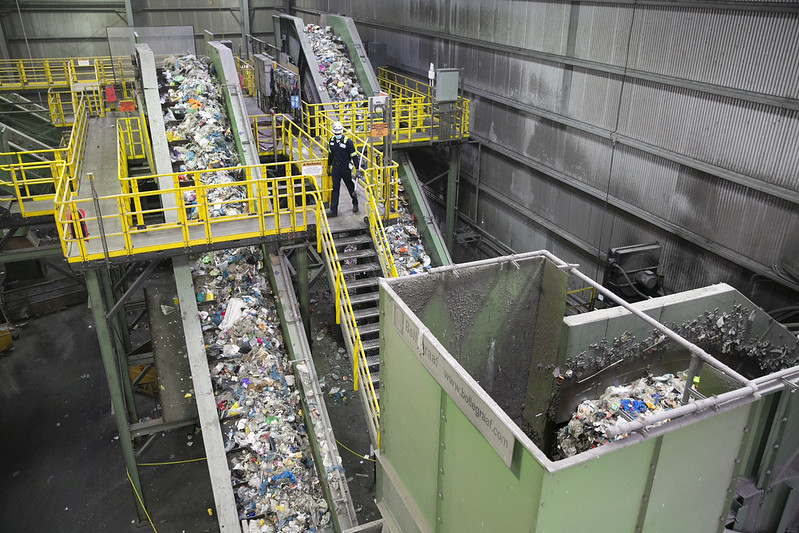
Recycling (photo: NYC Council)
New York has a waste problem, and it demands a bold, collaborative solution.
For years, New York has talked about Extended Producer Responsibility legislation to address this crisis. As an organization that is committed to leveraging innovation to protect our environment, the American Chemistry Council supports working toward and enacting a strong, effective EPR bill that helps increase our ability to recapture and recycle what we do produce.
Unfortunately, there’s a last-minute attempt to push a bill (S.4246) through the State Legislature that threatens to do more harm than good to both our environment and our economy.
Addressing a problem that will impact every citizen and business in New York is going to take the collaboration and participation of our government, businesses and citizens alike. And it will require leadership, innovation, expertise, and resources. Fortunately, New York has these things in abundance.
That’s why it’s so puzzling lawmakers in Albany are taking this approach. Rather than assembling a broad cross section of experts who can offer solutions and stakeholders who will be impacted by those measures, a small handful of activists are pushing a costly and misguided approach.
The result? Expensive new job-killing mandates on businesses at a time when many are struggling with inflationary pressures. Additionally, the legislation would ban the very cutting-edge technology that would help modernize our over-burdened recycling infrastructure and play a critical role both in meeting the bill’s ambitious recycled-content requirements and reducing greenhouse gas emissions.
The bill smartly proposes that more packaging be made from recycled content, which is fantastic. But it does nothing to remove the barriers that make recycling difficult today, and it ignores the central role plastics play in contributing to sustainability and combating climate change – for instance, by reducing the amount of material and energy used in the shipping of goods and helping keep products fresher for longer.
There are many ways to strengthen this legislation so it can better achieve its goals without harming New Yorkers. For instance, lawmakers should prioritize incentivizing environmental performance, so any proposed solutions effectively reduce waste and greenhouse gas emissions, rather than focusing on banning products and imposing costly and difficult-to-meet mandates on businesses. And they should encourage innovation by cutting bureaucratic red tape and providing the necessary support for businesses to develop and implement effective recycling solutions.
Serious environmental and economic challenges deserve thoughtful solutions shaped by input from a broad range of stakeholders. We are ready and eager to continue that conversation. That is why we urge legislators to reconsider S.4246 and engage the many willing partners across New York State who are eager to collaborate on an approach that helps protect our communities, our natural resources, and our jobs.
Solving our waste problem will require an all-hands-on-deck approach. In the weeks and months ahead, let’s get to work on finally making a truly effective Extended Producer Responsibility bill a reality.
***
Craig Cookson is Senior Director, Plastics Sustainability, at the American Chemistry Council. On Twitter @AmChemistry.
***
Have an op-ed idea or submission for Gotham Gazette? Email This email address is being protected from spambots. You need JavaScript enabled to view it.
How Governor Hochul Can Make Progress on Housing Through Executive Action
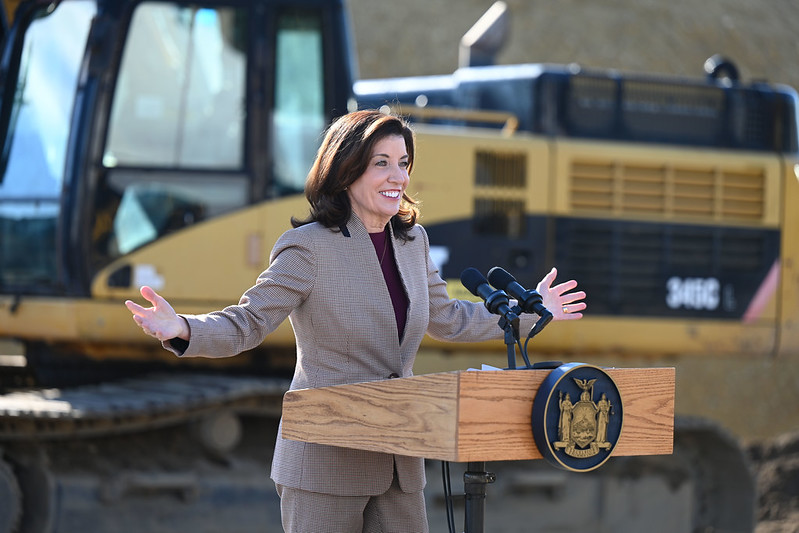
Governor Hochul (photo: Kevin P. Coughlin/Office of the Governor)
The most pressing issue facing New York is a lack of housing. A Regional Plan Association analysis shows that the state needs to build 817,000 more homes over the next decade to address shortages and meet expected population and job growth – the root cause of many symptoms currently ailing New York City.
For example, according to the city’s most recent Housing and Vacancy Survey, the median renter household makes $50,000 a year – but to afford a typically available apartment, renting for $2,750, that household needs to make $110,000. Is it any wonder that we have a nation-leading rate of chronic homelessness, with a nightly count surpassing 80,000 residents?
It was against this backdrop that Governor Hochul advanced ambitious housing goals this year, and it is against this backdrop that she, to her credit, will do so again next year despite the powerful and prevailing anti-housing forces. To be successful next session and to address the crisis of our age, however, there are several executive actions that the Governor can take on her own to spur housing development, regardless of local zoning.
With these actions, the Governor will show New Yorkers that she won’t back down from a challenge, and that “not in my backyard” isn’t an acceptable response.
First, the state should create affordable housing on the land it owns, as Governor Hochul has already signaled that she will do.
This is an opportunity for New York to fully maximize the potential of its own sites and lead by example. The Metropolitan Transit Authority owns some vacant parking lots on Long Island – it should follow in the footsteps of its California counterpart and work with other state agencies to redevelop them with housing. The state also has a number of abandoned psychiatric hospitals that could be redeveloped into housing – the 365 acres of the abandoned Kings Park Psychiatric Center, for example, are walking distance from a community college and an industrial park, and they’re only a mile-and-a-half from a Long Island Rail Road stop.
Second, Empire State Development (ESD), through the powers of the Urban Development Corporation, can build residential developments regardless of local zoning. This means that even without state land, ESD could use a “general project plan” to work with local landowners and private developers to build affordable and mixed-income housing. In exclusionary municipalities highly unlikely to ever allow affordable (or even multifamily) housing, this would be warranted.
Third and finally, the state should investigate localities that may be violating fair housing laws.
For instance, as a condition of approving a zoning change, Mount Pleasant recently forced Toll Brothers to age restrict a new development to residents over the age of 55 and local officials specifically cited school impact as a primary reason. While age-restricting a development is legal, it can be discrimination if you’re doing it specifically to exclude families with children.
Taken together, these measures are an important tool not just to create more housing, but also to affirmatively further fair housing. Restrictive zoning has not only driven up housing costs — it’s also resulted in sky-high levels of segregation.
The Regional Plan Association has demonstrated a clear correlation between exclusionary zoning and racial makeup of communities in the New York City region — with single-family zoned communities being almost entirely white, while multi-family-home communities are mostly inhabited by people of color. UC Berkeley found that New York has the most segregated school system in the country for Black students and the second most segregated school system for Latinos. And the Brookings Institute has shown that the New York City region has the second-highest level of Black-white residential segregation in the country, after only Milwaukee.
Over the last hundred years, zoning has become ever more restrictive across the state, and we have no reason to believe that municipalities will suddenly decide to do the right thing without state action. Instead, we must look to the state to solve the twin crises of housing supply and housing segregation.
State government respects leaders who are willing to play hardball. By taking strong, executive action on housing, the Governor can make it clear to all New Yorkers that she is going to tackle the biggest issues facing the state — and she will likely have greater leverage during next year’s budget process.
***
James Lloyd is the director of policy for the New York State Association for Affordable Housing. On Twitter @NYSAFAH.
***
Have an op-ed idea or submission for Gotham Gazette? Email This email address is being protected from spambots. You need JavaScript enabled to view it.
An AED on the Sidelines Saved Damar Hamlin; They Should Be Available to Everyone
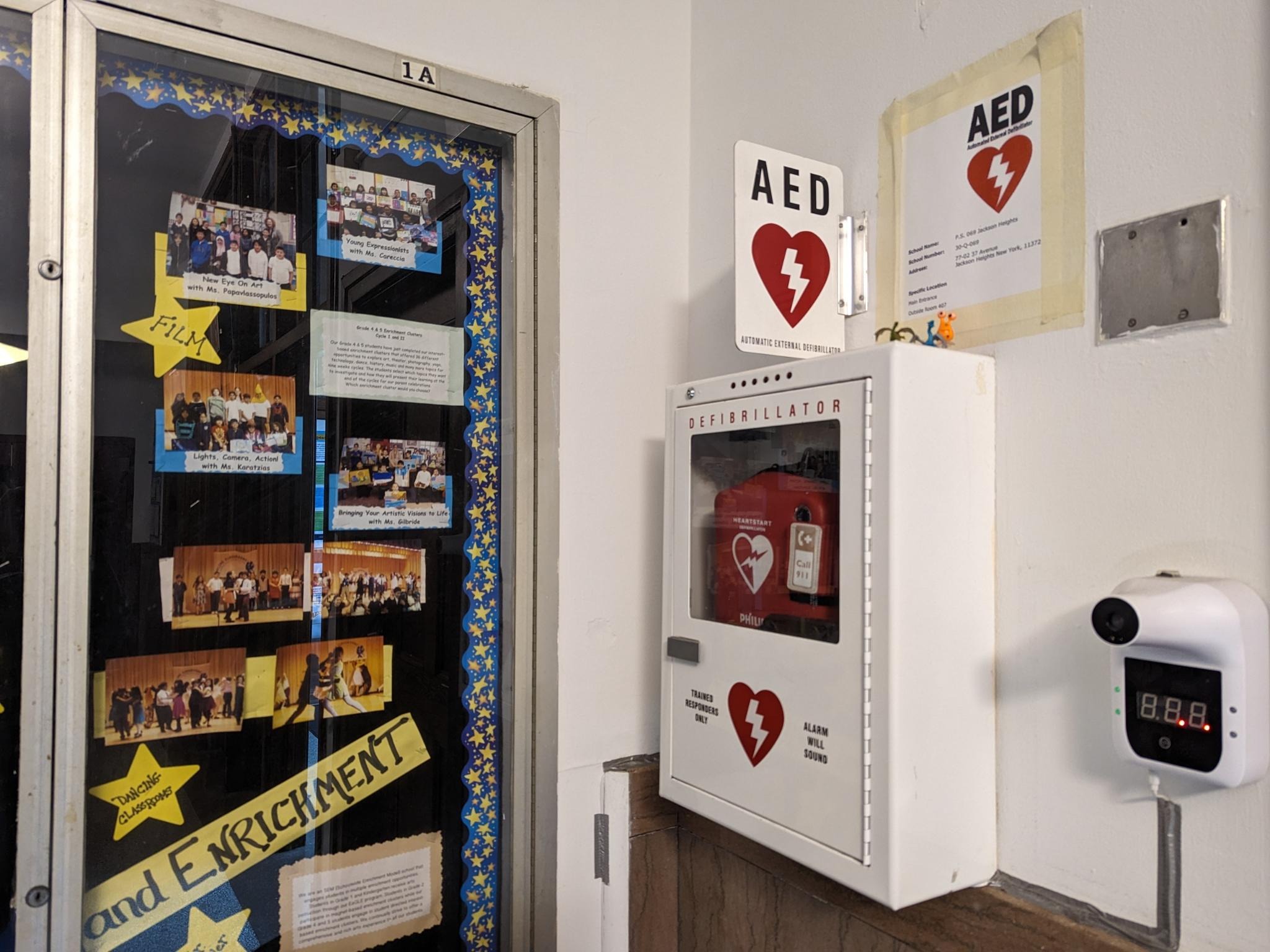
An AED in P.S. 69, Jackson Heights, Queens
In January, America watched in horror as Buffalo Bills safety Damar Hamlin collapsed onto the field, moments after making a routine tackle during a game against the Cincinnati Bengals. Twenty-four years old and in peak physical health, Hamlin had suffered a sudden cardiac arrest in front of thousands in the stands and millions tuned into Monday Night Football.
Thanks to good planning and training, the Bills' medical team on the sidelines had an automatic external defibrillator on hand, commonly known as an AED. Within seconds, these first responders used the AED to shock Hamlin's heart back into a normal rhythm as he awaited transport to a local hospital. The device not only saved his life, it also restored blood flow quickly enough to prevent permanent damage to his brain. Later that same month, Damlin was able to cheer on his team from the sidelines in its rematch against the Bengals. Today, he is back on the field, and his resilience and infectious optimism are an inspiration for us all.
As Damar’s story makes clear, AEDs save lives. Unfortunately, however, they aren't as readily accessible for everyone as they were for him. They should be, and we're both sponsoring legislation – on the federal and municipal levels – to make sure they are.
Each year, more than 356,000 people in the United States suffer cardiac arrest outside of the hospital, including more than 7,000 children. What the nation witnessed during Monday Night Football in January happens every day in our schools, playgrounds, and parks. A basketball player collapses after taking a rough shoulder check. A teacher trips and stumbles in the hallway clutching her chest. A high schooler falls to the grass after making a tackle during football practice.
In these terrifying situations, the evidence of AEDs' effectiveness is as impressive as it is unequivocal. According to the American Heart Association, the chance of survival for someone experiencing cardiac arrest outside of the hospital is less than 10%. That jumps to an average 40% survival rate when professional first responders like firefighters or emergency medical technicians use an AED. Incredibly, the chance of survival is highest when non-professional first responders use an AED: greater than 50%.
This is because non-professional bystanders – often coaches, teachers, or friends – can respond much more quickly than even the fastest ambulances in the critical moments right after the start of an irregular heart rhythm. It's also because modern AEDs are semi- or fully-automated. They provide clear verbal, and often visual, instructions that an average person can follow with only basic training.
The life-saving benefits of AEDs are obvious, which is why they have been placed in more and more public locations over the last several decades. President Clinton signed the Cardiac Arrest Survival Act in 2000, placing the devices in federal buildings and providing millions in grants for local deployment. Two years later, President Bush signed the Community Access to Emergency Devices Act, allocating millions more for states and localities to purchase AEDs and train first responders in their use. Besides the federal government, 20 states – including our own state of New York – require placement of AEDs in all public schools. But progress has stalled in recent years.
Hamlin's cardiac arrest makes a clear call to action: we must enact legislation to expand access to even more communities. At the federal level, Leader Schumer’s bipartisan Access to AEDs Act will provide grants to place devices in elementary and secondary schools nationwide, and will fund the development of school-based cardiac emergency response plans. And in New York City, Council Member Krishnan’s HEART (Harihareswara Expand Access to Rapid Treatment) Act will require the Department of Health to publish online the precise locations and quantities of all publicly-accessible AEDs within the five boroughs, whether in schools, firehouses, or government office buildings. If loaded into common mapping apps on our smartphones, this data can make AEDs as quick and easy to find as a cup of coffee.
Together, these laws can ensure that these miraculous devices are immediately accessible where most cardiac arrests occur – not in pro sports stadiums, but near our rec centers, public ballfields, and school yards. With easy-to-locate, ubiquitous AEDs, we can save countless people from cardiac death, from elite athletes like Damar Hamlin to ordinary New Yorkers like us.
***
Charles Schumer is the U.S. Senate Majority Leader. Shekar Krishnan is a City Council Member representing parts of Queens. On Twitter @SenSchumer & @voteshekar.
***
Have an op-ed idea or submission for Gotham Gazette? Email This email address is being protected from spambots. You need JavaScript enabled to view it.
5G Towers: To Increase Digital Connectivity, Start by Connecting with the Community
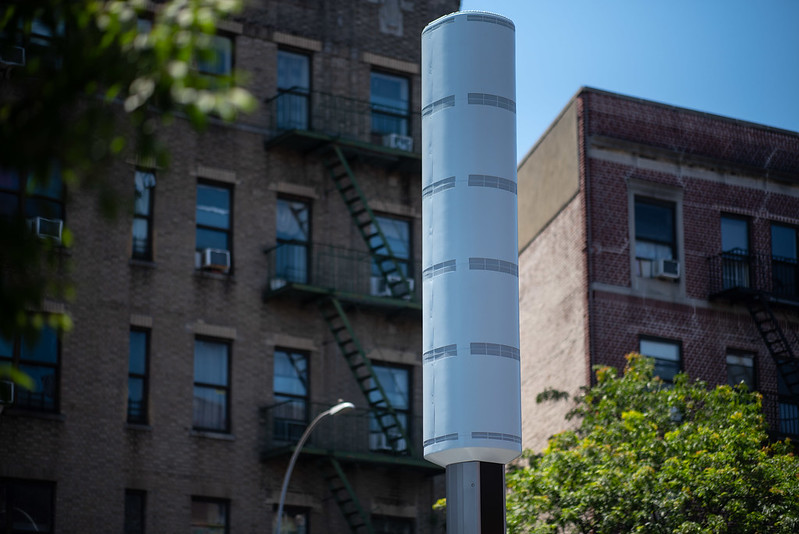
A 5G tower (photo: Michael Appleton/Mayoral Photography Office)
If you have walked around New York lately, you may have noticed a new addition to the streetscape: 32-feet-tall 5G towers looming over city sidewalks. As expected, these towers have inspired a range of colorful descriptions from New Yorkers for their uninspired design and massive size. From Washington Heights to Carnegie Hill, everyone seems to be raising the same questions and concerns about the design and placement of the 5G towers.
The city’s goal of expanding 5G communications is both laudable and necessary; in the new hybrid world of remote meetings and online work, access to high-speed internet is essential. The 5G towers, which are operated by a consortium named CityBridge, are supposed to be part of the solution by bringing complete connectivity to all parts of the city. To achieve this important goal, nearly 2,000 5G towers are to be installed citywide.
As representatives for the communities receiving the first rollout, we can attest that the process has not been a success -- with a failure to provide essential data about siting locations, insufficient community engagement, and a negligence of the appropriate federal siting approval processes.
For instance, a very common and reasonable request is for the city to explain why a certain location or block was chosen. CityBridge claims that network carriers, like AT&T, Verizon, and T-mobile, have shared coverage gaps with them and that determines where the towers go. However, to date, they have failed to share this data with elected officials or the public.
This lack of information leads many New Yorkers to rightfully question if this new arrangement is an effort to drive more revenue rather than the altruistic goal of expanding service to the most necessary and desirable locations.
Furthermore, the design of these towers leaves much to be desired, especially when placed near historic districts and landmarked buildings. Greater efforts should be made to ensure the design matches the surrounding area. We can also approach the towers as a creative opportunity by allowing artists to add a splash of color, much like the MTA partners with artists and poets to enhance the subway. Doing so could transform towers into local landmarks as opposed to dull, unappealing poles on the sidewalk.
Considering the issues raised, we believe that the towers – where truly necessary -- should be installed in a more deliberate, transparent manner that provides an opportunity for people near potential sites to have a say in the siting process while accessing the necessary data to back up the choice of location.
This week, the New York City Council’s Committee on Technology will hold an oversight hearing on the rollout of the 5G towers to explore these questions and more. The hearing will be an opportunity to hear from technology experts, community groups, and CityBridge. It will hopefully shed light on what is truly guiding the placement of these towers and where they are needed.
The hearing will also allow us to better understand how 102 towers were installed without going through the appropriate FCC review processes. In an April 20 letter, the FCC determined that CityBridge had not gone through the required historic preservation and environmental reviews as mandated under the National Historic Preservation Act and National Environmental Policy Act, respectively. The letter also ordered that the 102 towers already installed be subject to a “post construction review.”
The rollout of citywide 5G represents an opportunity to bridge the digital divide and ensure every New Yorker has online access. However, crucial questions must be answered to determine if the current approach is the best way to go about it. An opaque, top-down process understandably invites suspicion and controversy, and it is time to bring the public to the table. At the end of the day, these towers are installed in public space and the public has a right to be a part of the process.
***
City Council Members Keith Powers and Carmen De La Rosa each represent parts of Manhattan. On Twitter @KeithPowersNYC and @CnDelarosa.
***
Have an op-ed idea or submission for Gotham Gazette? Email This email address is being protected from spambots. You need JavaScript enabled to view it.
New York Must Do More to Prevent Public Transportation from Being a Breeding Ground for Sex Crimes
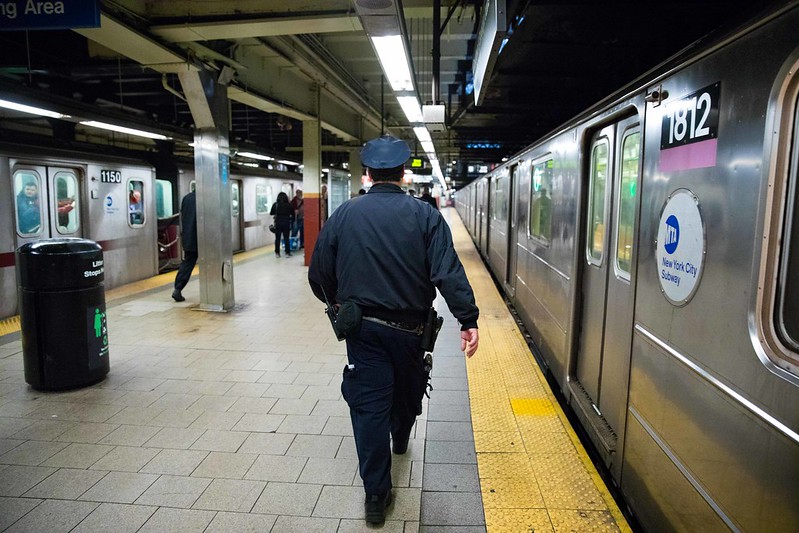
In the subway system (photo: Benjamin Kanter/Mayoral Photo Office)
Unfortunately fitting for its nickname “the city that never sleeps,” New York City transit sex crimes have a strong case of insomnia. Those who commit these crimes pay no attention to time of day, don’t care if you’re on a station platform or in a subway car. They are fearless, even in the presence of bystanders right next to them, join you as an unwanted guest as you move around the city, then escape past police officers patrolling the next stop.
Unfortunately, official data provided by the NYPD does not specify the number of sex crimes occurring in transit, so the relation between the two is unclear. When comparing data from Quarters 1 and 2 of 2022 and Quarters 1 and 2 of 2023, overall transit crime has reportedly decreased by 7%, while sex crimes other than rape increased by 5% throughout the city. Despite a decrease in transit crime, there are concerns over the sustainability of police officers working overtime in the subway system. Additionally, recent criminal justice reforms have failed to effectively address repeat offenders, especially those who commit violent felonies.
These statistics only tell a portion of the story. Countless more crimes occur every day on the subway but go unreported, much less result in convictions. This past year alone, I was sexually assaulted on the subway, twice. From the moment of contact, I was overcome with hopelessness. I feared immediate retaliation from the offenders had I spoken up, and never reported the crimes because I thought of how easy it would be for my attackers to evade arrest simply by slipping into the anonymity of New York City at the next stop.
My story is far too common. Subway sex crimes have been of public concern since at least 1953. The nature of transportation and the difficulty to surveil such a massive system provides a breeding ground for these transient offenders to go undetected and unidentified. Less than 50% of subway sex crimes lead to an arrest, and the cases that are cleared show a pattern: those who are convicted often have no prior criminal record.
Why isn’t this problem being adequately addressed? The majority of the victims of subway sex crimes are women, and as a society, we still tend to blame the victim for sexual assault, rather than the perpetrator. Some women who have experienced groping, forcible touching, and rape on the subways have reportedly felt afraid and ashamed and don’t come forward to report crimes. They also felt they didn’t have enough time to stop and file a report, or discuss their lack of faith in law enforcement and the government to protect their rights or find their assailant.
Similar to attempts at banning repeat offenders from transit systems related to crimes such as fare evasion or robbery, then-State Senator Diane Savino introduced a bill to address “subway gropers” by classifying forcible touching as a Class D Felony that could result in up to seven years in prison. That bill has repeatedly stalled in the Assembly. Her successor, Senator Jessica Scarcella-Spanton, has expanded upon Savino’s original bill in the current legislative session, legislation currently in the Senate’s codes committee but yet to move.
Others argue for a short-term or lifetime ban of sex offenders from using the transit system. Even if passed, a ban would be very hard to enforce because of the size and scope of the system and that units such as the Transit Special Victims Squad are perennially understaffed and overworked.
Admittedly, the transient environment of the subway makes it extremely difficult to track down offenders, and it’s impossible to staff the entire system with police. Each time I was assaulted, bystanders asked afterwards why I didn’t call the cops. It felt illogical and pointless for me to report a crime that had occurred 10 minutes ago and in a different location from where I currently was, especially if the perpetrator exited the train immediately after the sexual assault and I wasn’t at my destination yet. One of my offenders appeared homeless, and I knew finding and charging him would be even more unlikely.
Although Governor Hochul recently announced the implementation of 5,400 cameras to surveil the transit system, including every subway car, we must currently depend upon blurry and low-resolution stills from security cameras to attempt to find offenders, which proves challenging.
Initiatives that allow victims to speak up and share their stories are important. In 2018, The Call is Yours Campaign and the Transit Sex Offense Awareness website urged victims to report crimes on their own time, which gives the victim a voice, but did not necessarily result in justice. Despite the introduction of such initiatives, it remains nearly impossible to find data that supports their effectiveness.
Many factors that can contribute to a reduction in subway sex crimes may be out of victims’ control, but we can still speak up, and there are actions we can take on our own, such as reintroducing initiatives like The Call is Yours Campaign that allow victims to share their experiences with transit sexual assault.
As I understand what other victims go through, I often ask myself what could have prevented the sexual assaults and how it could be addressed in the aftermath. Research shows that the certainty of suffering consequences for committing a crime, rather than the severity, is effective in deterring such offenses; therefore, if potential offenders know a victim’s reports would lead to real consequences, they may think twice. This means better enforcement and a real commitment to ensuring adequate resources for law enforcement to pursue these cases quickly, with regular reminders via subway announcements about reporting sex crimes, ensuring that victims have a better sense that their claims will be heard and followed.
Awareness campaigns for “The Call is Yours” and the Transit Sex Offense website need to become prominent. I had never heard of either. In fact, the news has not covered The Call is Yours Campaign in recent years. Although the campaign reportedly led to an increase in the number of reported rapes in 2018, no current data is available. I believe it would have been especially beneficial for me and would help other victims who are commuting and unable to immediately stop to report the crime in person had we known of and been able to utilize campaigns that are there to help.
Although fearing retaliation in the moment is a real concern, knowing that soon after the crime occurred I not only could but would be encouraged to report it may have reassured me that New York City cares about this type of crime and these types of victims. Until more is done, I question when anonymity will stop hiding offenders from punishment, and when subway sex crimes won’t appear to be normalized as part of many women’s public transportation experience.
***
Nicole DiMaria is a Master’s candidate in the Forensic Psychology program at John Jay College of Criminal Justice and is a Research Fellow at the Initiative for Gender Equity in the Public Sector (IGEPS).
***
Have an op-ed idea or submission for Gotham Gazette? Email This email address is being protected from spambots. You need JavaScript enabled to view it.
New York’s Public Campaign Finance Law is Meant to Empower Small Donors; Changes Being Considered Could Undermine It

The New York State Capitol (photo: Mike Groll/Governor's Office)
Just a few weeks ago, lawmakers in Albany followed through on a commitment to place the state’s small donor public campaign financing program – which they enacted in 2020 – on a strong foundation heading into the 2024 elections. By including nearly $40 million for the program in this year’s state budget, the Legislature ensured that everyday voters, not just the wealthiest few, would have a chance to make their voices heard in our democracy.
But suddenly that commitment is in doubt, following reports that the Legislature is considering amendments that would seriously blunt the public financing program’s impact.
New York’s Public Campaign Finance Program is the nation’s boldest response to the corrupting influence of big money in politics. It provides a multiple match on donations from New York residents of $250 or less. With a six-to-one matching ratio for statewide races, a $10 donation gets a $60 match and is now worth $70 for the candidate. For legislative elections, in-district donations are matched on a sliding scale, with the smallest amounts matched at the highest ratio. The impact is obvious: small donations – and the constituents who make them – become more important to candidates.
But reports indicate that changes are afoot, and one proposal will gravely dilute this impact. That rumored change would permit the first $250 of any political contribution – up to the contribution limit for each office – to be eligible for public matching funds. That means a donation of $5,000 to a Senate candidate, say, would become worth $7,300. Amplifying such large contributions undercuts the program’s explicit purpose to make a government more accountable to all New York voters and weakens the impact of the small donors the law seeks to empower.
Large donors don’t need any extra help. Thanks in large part to the Supreme Court’s Citizens United ruling, the influence of big money in our politics has soared over the past decade, both nationally and in New York. In the 2022 statewide elections, the 200 biggest donors to candidates gave almost $16 million. That’s more than all 206,000 of the state’s small donors of $250 or less put together. This influence imbalance gives the wealthiest donors a seat at the head of the political table and leaves most New Yorkers out in the cold.
No wonder so many of us think politicians are more likely to listen to big donors than to the public. A recent poll found that 9 in 10 New Yorkers believe wealthy donors have more influence on politicians than the average voter, and a majority of New York voters across all regions and party affiliations support the state’s small donor matching program.
Under the program that lawmakers committed to in 2020 and funded last month, participating candidates would be able to fundraise the same way they campaign: by spending time with voters. This shift would encourage a new and more representative population of donors and strengthen public officials’ connections to the constituents they seek to represent.
That’s not speculation. A recent Brennan Center analysis shows that the program as it exists today will make small donors the most important source of campaign funding in the state. If public financing had been available in last year’s legislative elections, it showed, the financial power of small donors could have increased sixfold, from representing 11 percent of political contributions to as much as 67 percent. That’s a clear win for the millions of New Yorkers who have been silenced by big money.
Sixty-one percent of voters in the Mid-Hudson region, which includes Westchester County, support this groundbreaking program, and a large majority of voters across the state, including this region, wanted state leaders to adequately fund the program this year.
When they agreed to fund public campaign financing for the 2024 election cycle, state lawmakers followed through on their commitment to empowering everyday New Yorkers in the political process. Their leadership set an example for the nation. But it will take continued leadership to ensure that the Public Campaign Finance Program delivers on its full promise for the people of New York.
***
Shannon Powell is the co-founder of Indivisible Westchester, a grassroots progressive organization with more than 4,000 members. Karen Wharton is the Democracy Coalition Coordinator for Citizen Action of New York.
***
Have an op-ed idea or submission for Gotham Gazette? Email This email address is being protected from spambots. You need JavaScript enabled to view it.
A Key Step New York Must Take to Stop Right-Wing Extremists
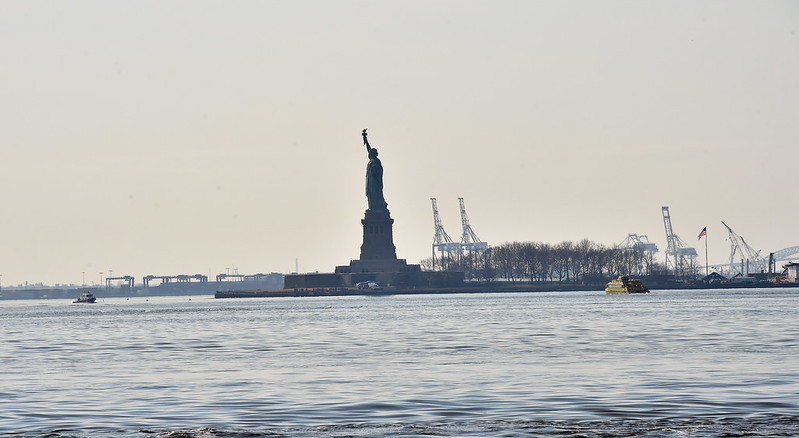
The Statue of Liberty (photo: Kevin P. Coughlin/Governor's Office)
On January 6, 2021, Americans watched in horror as right-wing extremists tried to violently overthrow our government and pull down the foundations of our democracy. To anyone who saw those shameful events unfold it should come as no surprise that the same anti-democratic forces that stirred up the insurrection on January 6 now have their sights set on the United States Constitution. They hope to do the Constitution the same violence they perpetrated on the U.S. Capitol, with the goal of rolling back women’s rights, destroying our climate, stripping Americans of their civil liberties, and diluting federal powers that protect Americans in every aspect of their lives.
Sound alarmist? Unfortunately, it’s not. But New York lawmakers have the power to stop them in their tracks with the stroke of a pen.
There is a resolution currently in the State Legislature that would stymie the extremists’ strategy by immediately removing New York from the list of states calling for an Article V convention.
So what is an Article V convention?
Article V of the United States Constitution provides for one of two ways to amend the country’s central governing document. The way most of us are familiar with involves a two-thirds vote in both the U.S> Senate and the House of Representatives, which then must be ratified by the states. The other way is by calling for a convention with two-thirds of the states in agreement (34 total) through the passage of resolutions in local statehouses. Proponents of an Article V strategy already have 29 states. New York could be next.
Who exactly is behind this effort? A group called the Convention of the States has been working towards this goal for years, with well known right-wing radicals like Ben Shapiro and Rick Santorum featured on their website. The group’s main agenda is clear: using a limited Article V Convention call to propose constitutional amendments that impose, at a minimum, limitations on the size and scope of the federal government. As former Justice Antonin Scalia put it: “Who knows what would come out of it?”
We do. And it’s chaos.
During an Article V convention there are no rules, guidelines, or even language on how it could work. Once the convention is called, there is an opportunity for a runaway train scenario that could potentially rewrite any constitutional right or protection currently available to American citizens. Here in New York that could be a death knell for the very rights we are fighting to protect and expand. We pride ourselves on leading the way on labor rights. We raised the minimum wage. We protect our families by offering paid leave. We are a proud union state. We’ve safeguarded a woman’s right to choose, expanded gun safety protections, and taken meaningful steps in revamping our state’s ethics board. We invested in resiliency and climate action. But with the threat – and reality – of a convention, these rights, and investments, could very well be stripped away. And we can’t let that happen.
States like New Mexico, Maryland, Nevada, and Delaware have already moved to protect their residents and the country, and New York should be next. At a time of extraordinary threats to our rights as Americans and our very democracy itself, the United States Constitution stands as a bulwark against a rising tide of destructive and hateful ideologies. We can’t allow it to be torn down.
***
Susan Lerner is the executive director of Common Cause/NY and Liz Krueger is a state senator representing Manhattan. On Twitter @slerner212 & @LizKrueger.
***
Have an op-ed idea or submission for Gotham Gazette? Email This email address is being protected from spambots. You need JavaScript enabled to view it.




